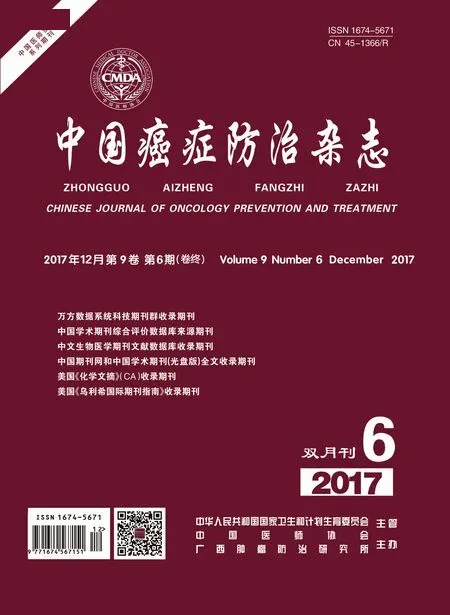甲状腺癌和乳腺癌相关病因及发病机制进展
廖曼各 吕春艳 张丽林 任艳鑫 李晓江
甲状腺癌与乳腺癌的关系早在19世纪就引起广泛关注。研究发现,有甲状腺癌病史的患者,再发乳腺癌的风险增高,而有乳腺癌病史的患者再发甲状腺癌的风险亦增高[1-3]。Kim等[1]研究原发性甲状腺癌患者再发第二原发肿瘤,发现再发乳腺癌居患者第二原发肿瘤的首位。一项首尔国立大学的研究表明[2],有4.3%甲状腺癌患者再发乳腺癌,2.6%乳腺癌患者再发甲状腺癌。Zhang等[3]对18 732例原发性乳腺癌患者和12 877例原发性甲状腺癌患者进行回顾性研究,发现原发乳腺癌并发甲状腺癌的发病率为0.49%,原发甲状腺癌并发乳腺癌的发病率为0.91%,其最常见的病理类型为甲状腺乳头状癌合并乳腺导管浸润性癌。甲状腺和乳腺同为激素依赖性器官,内分泌功能的变化与腺体疾病的发生有密切关系。目前普遍认为激素在甲状腺癌和乳腺癌的发生、发展中起重要作用,同时遗传易感性、自身免疫、辐射暴露等因素也起到一定作用。本文对乳腺癌与甲状腺癌的相关病因及发病机制研究进展作一综述。
1 雌激素
雌激素属于类固醇激素,其来源和在体内的存在形式有多种,由卵巢产生的雌二醇(estradiol,E2)在含量和效力上最高,其生理作用主要通过与雌激素受体(estrogen receptor,ER)结合调节生殖系统的生长、分化和各种生理机能,同时也影响骨、肝脏、甲状腺、脑以及心血管系统生长发育。研究证明,雌激素在甲状腺癌和乳腺癌的发生发展中起着重要作用。
1.1 雌激素与乳腺癌
大量临床和实验研究证实,雌激素暴露是乳腺癌的重要影响因素。雌激素通过与ER结合后与雌激素反应元件相互作用,对下游基因的转录产生调控作用,促进乳腺癌的发生和发展,并诱导乳腺癌细胞侵袭转移至远处器官或淋巴结,同时还能抑制乳腺癌细胞凋亡[4]。雌激素在ER(-)乳腺癌的发病中也具有重要作用,E2与细胞膜上的G蛋白偶联受体30(G protein-coupled receptor 30,GPR30)作用使 ER(-)乳腺癌细胞内的细胞骨架连接蛋白重排,促进癌细胞侵袭和迁移[5]。此外,雌激素的代谢产物2-羟基儿茶酚雌激素和4-羟基儿茶酚雌激素通过氧化还原反应产生醌类物质,形成DNA加合物,使DNA氧化损伤而产生致癌作用[6]。
1.2 雌激素与甲状腺癌
甲状腺癌男女发病比例为1∶3,青春期后发病率迅速升高,与内源性雌激素的分泌水平变化一致。研究[7-8]表明口服避孕药后甲状腺的体积增大,且使用雌激素治疗的妇科病患者其甲状腺癌的发病风险增高。雌激素促进甲状腺癌发生发展主要有以下几种机制:⑴雌激素与肿瘤干细胞:外用雌激素增加了甲状腺肿瘤干细胞增殖和分化,促进肿瘤干细胞的能动性和致癌性,且存在剂量依赖性[9];⑵雌激素与癌细胞增殖转移:Kumar等[10]研究表明,E2作用于ER刺激细胞调节蛋白激酶ERK1/2通路磷酸化,促进细胞内的组织蛋白酶D和cyclinD1表达,从而促进甲状腺癌细胞增殖;另有研究[11]显示,E2通过调节上皮钙粘蛋白、波形蛋白和基质金属蛋白酶-9促进甲状腺癌细胞转移;⑶雌激素抑制肿瘤细胞凋亡:Mo等[12]研究发现,E2促进热休克蛋白27与pro-casepase 3的交互作用,从而抑制甲状腺癌细胞凋亡。Fan等[13]研究显示E2诱导ERα阳性的甲状腺癌细胞产生保护性自噬,产生自噬蛋白LC3并未促进癌细胞死亡,反而抑制癌细胞凋亡。此外,E2刺激甲状腺癌细胞分泌大量的血管内皮生长因子(vascularendothelial cellgrowthfactor,VEGF)[14],VEGF 在调节肿瘤血管级联反应包括细胞增殖、转移、内皮细胞血管新生等方面发挥关键作用。
2 雌激素受体
雌激素受体属于类固醇激素受体家族,主要有ERα、ERβ两种亚型。雌激素主要通过以下两条信号通路与ER相互作用:⑴核起始的雌激素信号通路:细胞核中的ER与DNA直接结合或通过其他转录因子与DNA非直接结合调节基因表达;⑵膜起始的雌激素信号通路:雌激素与膜ER结合通过调节信号传导通路如磷脂酰肌醇-3羟基激酶/蛋白激酶B(phoshoinositide-3-kinase/protein kinase B,PI3K/Akt)和丝裂原活化蛋白激酶(Mitogen-activated protein kinase,MAPK)信号通路调节细胞生长,也被称为非基因组模式。
2.1 雌激素受体与乳腺癌
ERα在正常的乳腺上皮细胞中表达少于10%,在乳腺癌组织中表达却增加到50%~80%,ER的异常表达促进乳腺癌的发生及发展[15]。ERα在乳腺发育中所扮演的角色已在ERα基因敲除小鼠中得到证实[16]。研究[17]显示,在乳腺癌中ERβ通过抑制MAPK及PI3K通路活性从而抑制肿瘤细胞增殖、促进细胞凋亡,并提高化疗疗效。也有少量研究指出ERβ表达促进细胞增殖,且是乳腺癌不良预后的因素之一[18]。
2.2 雌激素受体与甲状腺癌
国内外大部分学者认为甲状腺癌组织表达ER,且ER在甲状腺癌组织中的表达率显著高于正常甲状腺组织,但与患者性别、年龄、肿瘤大小、转移等关系的报道不一致。Tavangar等[19]研究发现,在 PTC、滤泡状癌、滤泡状腺瘤和结节性甲状腺肿组织中可检测到ERα表达,PTC的阳性率明显高于滤泡状癌和良性病变者。Sturniolo等[20]研究发现,PTC患者中ER阳性患者的肿瘤直径更大,并对研究的192名患者进行随访,发现ER阳性患者的复发率更低。Jalali-Nadoushan等[21]研究发现ER的表达与甲状腺癌的大小、淋巴结转移、性别、病理分期无关。还有学者[22]研究显示ERα促进甲状腺癌发生和进展,而ERβ抑制甲状腺癌发生和发展。
3 钠碘转运体与甲状腺癌和乳腺癌的关系
钠碘转运体(sodium/iodide symporter,NIS)是一种调控甲状腺滤泡细胞吸收碘的跨膜糖蛋白。研究[23-24]发现,甲状腺癌组织中功能性NIS表达较正常甲状腺组织明显下降,且恶性程度越高,NIS表达率越低。还有学者[25]研究结果显示甲状腺癌NIS低表达可能与甲状腺常见突变基因BRAF(V600E)突变有关。
NIS除了在甲状腺、哺乳期乳房和唾液腺组织中表达外,还在多数乳腺癌组织中表达。Chatterjee等[26]在100多例乳腺癌组织标本中检测h NIS表达,结果显示超过70%的乳腺癌组织标本h NIS表达呈阳性,且发现89%的 ER阳性乳腺癌组织标本表达NIS,61%的ER阴性乳腺癌样本NIS表达阳性。Lukianova等[27]研究发现,相比恶性程度低的MCF-7和T47D乳腺癌细胞,恶性程度较高的乳腺癌细胞NIS表达率更高,提示NIS与乳腺癌侵袭性相关。
4 甲状腺激素与甲状腺癌和乳腺癌的关系
甲状腺激素为甲状腺分泌的促进机体生长发育和新陈代谢的激素,通过结合甲状腺激素受体(thyroid hormone receptor,TR)发挥生理效应。甲状腺激素的合成与分泌主要受促甲状腺激素(thyroid stimulating hormone,TSH)调控,分子类型包括三碘甲状腺原氨酸(triiodothyronine,T3)、甲状腺素(thyroxine,T4),T3 主要由 T4 脱碘生成。在人体中,T4约占甲状腺激素的80%,但发挥生理效应主要为游离T3。研究[28]发现,TSH是甲状腺癌发病的危险因素,甲状腺癌患者血清TSH表达水平高于正常人,TSH的持续刺激可导致甲状腺滤泡上皮细胞过度增生从而发生癌变。临床发现结节性甲状腺肿合并的甲状腺癌多为乳头状癌,这可能是由于甲状腺滤泡上皮增生中出现乳头状增生和血管增生。
研究发现,甲状腺功能亢进增加了乳腺癌的发病风险,而甲状腺功能低下降低了乳腺癌的发病风险[29]。王亘等[30]研究表明,乳腺癌患者外周血中的总T4和游离T4水平高于良性对照组和健康组。一项体外研究[31]将E2和T3加入T47-D细胞中,发现E2和T3浓度与乳腺癌细胞生长呈正相关,进一步分析发现,T3通过上调E2介导的相关基因及ER的表达增强雌激素作用。Moretto等[32]研究发现,T3通过激活PI3K通路,诱导MCF7细胞中缺氧诱导因子α和转化生长因子α产生,促进了乳腺癌的发生、发展。亦有体外研究[33]显示低甲状腺激素水平在减缓乳腺肿瘤生长的同时促使乳腺癌细胞发生上皮-间质转化,增加了乳腺癌细胞的侵袭性,提示甲状腺激素对乳腺癌的作用可能并不单一。TR的亚型TRβ1基因的异常突变及缺失与乳腺癌的发生发展相关。将TRβ1转染至乳腺癌细胞系后,降低了癌细胞对生长因子的反应,抑制了MAPK和PI3K/ATK等信号通路活化,使癌细胞生长受抑,从而抑制乳腺癌侵袭和转移能力[34-35]。Nielsen等[36]研究报道,TSH 可单独或与雌激素协同作用促进乳腺癌发生,但具体机制尚不明确。此外,TSH还可通过促进T3、T4合成与释放,从而促进乳腺癌发生。
5 其他
肿瘤的发生,除了外在的化学、物理、生物学因素,还有内在的遗传、免疫、内分泌等因素。类固醇激素受体的另一成员孕激素受体(progesterone receptor,PR)在乳腺癌组织中表达水平升高,促进了乳腺癌的发生发展[15]。PR在甲状腺癌组织中也存在高表达,但与甲状腺癌进展无关[20]。学者研究发现家族史中患有乳腺癌的人群甲状腺癌的发病风险更高,反之亦然[37]。Cowden综合征(cowden syndrome,CS)是一种罕见的常染色体显性遗传病,研究发现CS增加了同一个体罹患乳腺癌和分化型甲状腺癌的风险[38]。还有研究[3]显示甲状腺癌并发乳腺癌患者甲状腺过氧化物酶抗体(thyroid peroxidase antibody,TPOab)表达水平高于单发甲状腺癌患者。高丽霞等[39]研究显示乳腺癌患者TPOab水平显著高于乳腺良性疾病患者和正常对照组人群。但Brandt等[40]研究则显示低TPOab水平会增加乳腺癌的发病风险。
研究[36]报道,广岛、长崎原子弹爆炸、切尔诺贝利核事故同时增加了甲状腺癌和乳腺癌的发病率(特别是儿童),提示辐射暴露可能通过相似机制造成两种肿瘤发生,这个机制可能是辐射暴露导致DNA损伤修复机制异常。放疗是公众接受的最重要的额外照射,但放疗后随着患者生存率增加和寿命延长,第二原发癌亦增加。Grantzau等[41]研究发现,经过放疗的乳腺癌患者甲状腺癌发病风险增加,特别是乳腺癌放疗10年后甲状腺癌的发病风险大大增加。但研究发现,经过131I治疗的甲状腺癌患者其乳腺癌的发病风险并未增加[42]。
6 结语
综上所述,甲状腺癌和乳腺癌可能存在共同的致病因素,雌激素及受体、甲状腺激素、NIS、遗传易感性、辐射暴露等各种因素与甲状腺癌和乳腺癌的发生、发展有密切关联,这为临床医生警惕甲状腺癌再发乳腺癌或乳腺癌再发甲状腺癌提供了依据。除了常规超声和钼靶检查,还可通过测定激素水平监测甲状腺癌和乳腺癌发生。研究两者之间的关系,有利于早期预防和检测第二原发肿瘤的发生,同时为甲状腺癌和乳腺癌的治疗提供新的方向。如雌激素在甲状腺癌中的作用使内分泌治疗成为可能,现已有部分学者在体外实验将内分泌治疗应用于甲状腺癌[43],而NIS在乳腺癌中的高表达也使放射碘应用于乳腺癌成为可能。此外,研究甲状腺癌和乳腺癌的关系,有利于更好地了解肿瘤的生物学行为,为临床实践提供依据。
[1] Kim C,Bi X,Pan D,et al.The risk of second cancers after diagnosis of primary thyroid cancer is elevated in thyroid microcarcinomas[J].Thyroid,2013,23(5):575-582.
[2] An JH,Hwangbo Y,Ahn HY,et al.A possible association between thyroid cancer and breast cancer[J].Thyroid,2015,25(12):1330-1338.
[3] Zhang L,Wu Y,Liu F,et al.Characteristics and survival of patients with metachronous or synchronous double primary malignancies:breast and thyroid cancer[J].Oncotarget,2016,7(32):52450-52459.
[4] Park SJ,Kim JG,Kim ND,et al.Estradiol,TGF-beta1 and hypoxia promote breast cancer stemness and EMT-mediated breast cancer migration[J].Oncol Lett,2016,11(3):1895-1902.
[5] Zhou K,Sun P,Zhang Y,et al.Estrogen stimulated migration and invasion of estrogen receptor-negative breast cancer cells involves an ezrin-dependent crosstalk between G protein-coupled receptor 30 and estrogen receptor beta signaling[J].Steroids,2016,111:113-120.
[6] Sampson JN,Falk RT,Schairer C,et al.Association of estrogen metabolism with breast cancer risk in different cohorts of postmenopausal women[J].Cancer Res,2017,77(4):918-925.
[7] Garcia TS,Rech TH.Thyroid volume and Doppler evaluation of inferior thyroid artery in ultrasound:Comparison between current and previous users of oral contraceptives[J].J Clin Ultrasound,2015,43(5):312-317.
[8] Caini S,Gibelli B,Palli D,et al.Menstrual and reproductive history and use of exogenous sex hormones and risk of thyroid cancer among women:a meta-analysis of prospective studies[J].CancerCausesControl,2015,26(4):511-518.
[9] Zane M,Parello C,Pennelli G,et al.Estrogen and thyroid cancer is a stem affair:a preliminary study[J].Biomed Pharmacother,2017,85:399-411.
[10]Kumar A,Klinge CM,Goldstein RE.Estradiol-induced proliferation of papillary and follicular thyroid cancer cells is mediated by estrogen receptors alpha and beta[J].Int J Oncol,2010,36(5):1067-1080.
[11]Dong W,Zhang H,Li J,et al.Estrogen induces metastatic potential of papillary thyroid cancer cells through estrogen receptor α and β[J].Int J Endocrinol,2013,2013:941568.
[12] Mo XM,Li L,Zhu P,et al.Up-regulation of Hsp27 by ERα/Sp1 facilitates proliferation and confers resistance to apoptosis in human papillary thyroid cancer cells[J].Mol Cell Endocrinol,2016,431:71-87.
[13]Fan D,Liu SY,Van Hasselt CA,et al.Estrogen receptor alpha induces prosurvival autophagy in papillary thyroid cancer via stimulating reactive oxygen species and extracellular signal regulated kinases[J].J Clin Endocrinol Metab,2015,100(4):E561-571.
[14]Kamat A,Rajoria S,George A,et al.Estrogen-mediated angiogenesis in thyroid tumor microenvironment is mediated through VEGF signaling pathways[J].ArchOtolaryngolHeadNeckSurg,2011,137(11):1146-1153.
[15]Kos Z,Dabbs DJ.Biomarker assessment and molecular testing for prognostication in breast cancer[J].Histopathology,2016,68(1):70-85.
[16]Couse JF,Korach KS.Estrogen receptor null mice:what have we learned and where will they lead us?[J].Endocr Rev,1999,20(3):358-417.
[17]Cotrim CZ,Fabris V,Doria ML,et al.Estrogen receptor beta growthinhibitory effects are repressed through activation of MAPK and PI3K signalling in mammary epithelial and breast cancer cells[J].Oncogene,2013,32(19):2390-2402.
[18]Markey GC,Cullen R,Diggin P,et al.Estrogen receptor-beta mRNA is associated with adverse outcome in patients with breast cancer[J].Tumour Biol,2009,30(4):171-175.
[19]Tavangar SM,Monajemzadeh M,Larijani B,et al.Immunohistochemical study of oestrogen receptors in 351 human thyroid glands[J].Singapore Med J,2007,48(8):744-747.
[20]Sturniolo G,Zafon C,Moleti M,et al.Immunohistochemical expression of estrogen receptor-alpha and progesterone receptor in patients with papillary thyroid cancer[J].Eur Thyroid J,2016,5(4):224-230.
[21]Jalali-Nadoushan MR,Amirtouri R,Davati A,et al.Expression of estrogen and progesterone receptors in papillary thyroid carcinoma[J].Caspian J Intern Med,2016,7(3):183-187.
[22]Huang Y,Dong W,Li J,et al.Differential expression patterns and clinical significance of estrogen receptor-alpha and beta in papillary thyroid carcinoma[J].BMC Cancer,2014,14:383.
[23]Wang ZF,Liu QJ,Liao SQ,et al.Expression and correlation of sodium/iodide symporter and thyroid stimulating hormone receptor in human thyroid carcinoma[J].Tumori,2011,97(4):540-546.
[24]Wei S,Gao M,Zhao C,et al.Low expression of sodium iodide symporter expression in aggressive variants of papillary thyroid carcinoma[J].Int J Clin Oncol,2014,19(5):800-804.
[25]Yazgan A,Yildirim N,Gözalan A,et al.The correlation of sodium iodide symporter and BRAF(V600E)mutation in classical variant papillary thyroid carcinoma[J].Ann Diagn Pathol,2016,22:58-62.
[26]Chatterjee S,Malhotra R,Varghese F,et al.Quantitative immunohistochemical analysis reveals association between sodium iodide symporter and estrogen receptor expression in breast cancer[J].PLoS One,2013,8(1):e54055.
[27]Lukianova NY,Andriiv AV,Chekhun VF.Correlation of iodine symporter expression in highly and low malignant cell lines of human breast cancer differed in their sensitivity to doxorubicin[J].Exp Oncol,2016,38(3):169-171.
[28]Nieto H,Boelaert K.Women in cancer thematic review:thyroid-stimulating hormone in thyroid cancer:does it matter?[J].Endocr Relat Cancer,2016,23(11):T109-T121.
[29]Søgaard M,Farkas DK,Ehrenstein V,et al.Hypothyroidism and hyperthyroidism and breast cancer risk:a nationwide cohort study[J].Eur J Endocrinol,2016,174(4):409-414.
[30]王亘,陈小松,毛艳,等.乳腺癌患者血清游离T4水平高于乳腺良性疾病患者[J].肿瘤,2014,34(4):366-369.
[31]Hall LC,Salazar EP,Kane SR,et al.Effects of thyroid hormones on human breast cancer cell proliferation[J].J Steroid Biochem Mol Biol,2008,109(1-2):57-66.
[32]Moretto FC,De Sibio MT,Luvizon AC,et al.Triiodothyronine(T3)induces HIF1A and TGFA expression in MCF7 cells by activating PI3K[J].Life Sci,2016,154:52-57.
[33] Martinez-Iglesias O,García-Silva S,Regadera J,et al.Hypothyroidism enhances tumor invasiveness and metastasis development[J].PLoS One,2009,4(7):e6428.
[34]Ling Y,Ling X,Fan L,et al.Mutation analysis underlying the downregulation of the thyroid hormone receptor beta1 gene in the Chinese breast cancer population[J].Onco Targets Ther,2015,8:2967-2972.
[35]Martinez-Iglesias O,Garcia-Silva S,Tenbaum SP,et al.Thyroid hormone receptor beta1 acts as a potent suppressor of tumor invasiveness and metastasis[J].Cancer Res,2009,69(2):501-509.
[36]Nielsen SM,White MG,Hong S,et al.The breast-thyroid cancer link:a systematic review and meta-analysis[J].Cancer Epidemiol Biomarkers Prev,2016,25(2):231-238.
[37]Goldgar DE,Easton DF,Cannon-Albright LA,et al.Systematic population-based assessment of cancer risk in first-degree relatives of cancer probands[J].J Natl Cancer Inst,1994,86(21):1600-1608.
[38]Ngeow J,Stanuch K,Mester JL,et al.Second malignant neoplasms in patients with Cowden syndrome with underlying germline PTEN mutations[J].J Clin Oncol,2014,32(17):1818-1824.
[39]高丽霞,张益枝,吴克雄,等.乳腺癌患者甲状腺功能的相关研究[J].现代肿瘤医学,2016,24(7):1071-1074.
[40]Brandt J,Borgquist S,Manjer J.prospectively measured thyroid hormones and thyroid peroxidase antibodies in relation to risk of different breast cancer subgroups:a malm?diet and cancer study[J].Cancer Causes Control,2015,26(8):1093-1104.
[41] Grantzau T,Overgaard J.Risk of second non-breast cancer among patients treated with and without postoperative radiotherapy for primary breast cancer:a systematic review and meta-analysis of populationbased studies including 522,739 patients[J].Radiother Oncol,2016,121(3):402-413.
[42]Zhang Y,Liang J,Li H,et al.Risk of second primary breast cancer after radioactive iodine treatment in thyroid cancer:a systematic review and meta-analysis[J].Nucl Med Commun,2016,37(2):110-115.
[43]Hoelting T,Siperstein AE,Duh QY,et al.Tamoxifen inhibits growth,migration,and invasion of human follicular and papillary thyroid cancer cells in vitro and in vivo[J].JClin Endocrinol Metab,1995,80(1):308-313.

